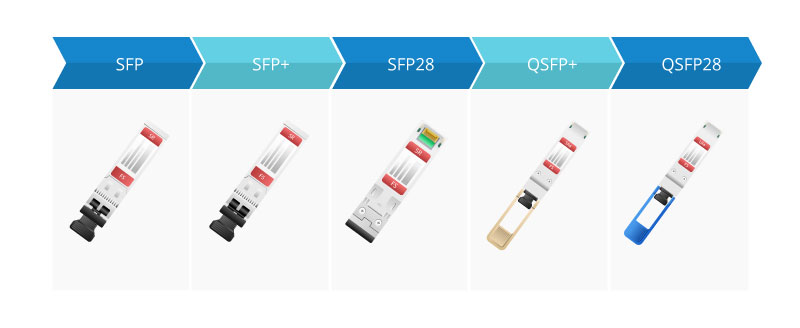SFP
SFP can be understood as an upgraded version of GBIC. Its volume is only 1/2 of that of GBIC module, which greatly increases the port density of network devices. In addition, the SFP's data transfer rates range from 100Mbps to 4Gbps.
SFP+
SFP+ is an enhanced version of SFP that supports 8Gbit/s fibre channel, 10G Ethernet and OTU2, the optical transmission network standard. In addition, SFP+ direct cables (i.e., SFP+ DAC high-speed cables and AOC active optical cables) can connect two SFP+ ports without adding additional optical modules and cables (network cables or fiber jumpers), which is a good choice for direct connection between two adjacent short-distance network switches.
SFP28
The SFP28 is an enhanced version of the SFP+, which has the same size as the SFP+ but can support single-channel speeds of 25Gb/s. SFP28 provides an efficient solution for upgrading 10G-25G-100G networks to meet the growing needs of next-generation data center networks.
QSFP+
QSFP+ is an updated version of QSFP. Unlike QSFP+, which supports 4 gbit /s channels at a rate of 1Gbit/s, QSFP+ supports 4 x 10Gbit/s channels at a rate of 40Gbps. Compared with SFP+, the transmission rate of QSFP+ is four times higher than that of SFP+. QSFP+ can be directly used when a 40G network is deployed, thereby saving cost and increasing port density.
QSFP28
The QSFP28 provides four high-speed differential signal channels. The transmission rate of each channel varies from 25Gbps to 40Gbps, which can meet the requirements of 100 gbit/s Ethernet (4 x 25Gbps) and EDR InfiniBand applications. There are many types of QSFP28 products, and different modes of 100 Gbit/s transmission are used, such as 100 Gbit/s direct connection, 100 Gbit/s conversion to four 25 Gbit/s branch links, or 100 Gbit/s conversion to two 50 Gbit/s branch links.
The differences and similarities of SFP, SFP+, SFP28, QSFP+, QSFP28
After understanding what SFP, SFP+, SFP28, QSFP+, QSFP28 are, the specific similarities and differences between the two will be introduced next.
The recomended Network Packet Broker to Support 100G, 40G and 25G, to visit here
The recomended Network Tap to Support 10G, 1G and intelligent Bypass, to visit here
SFP and SFP+ : Same size, different rates and compatibility
The size and appearance of SFP and SFP+ modules are the same, so device manufacturers can adopt the physical design of SFP on switches with SFP+ ports. Due to the same size, many customers use SFP modules on SFP+ ports of switches. This operation is feasible, but the rate is reduced to 1Gbit/s. In addition, do not use the SFP+ module in the SFP slot. Otherwise, the port or module may be damaged. In addition to compatibility, SFP and SFP+ have different transmission rates and standards. An SFP+ can transmit a maximum of 4Gbit/s and a maximum of 10Gbit/s. SFP is based on the SFF-8472 protocol while SFP+ is based on the SFF-8431 and SFF-8432 protocols.
SFP28 and SFP+ : The SFP28 optical module can be connected to the SFP+ port
As mentioned above, SFP28 is an upgraded version of SFP+ with the same size but different transmission rates. The transmission rate of SFP+ is 10Gbit/s and that of SFP28 is 25Gbit/s. If the SFP+ optical module is inserted into the SFP28 port, the link transmission rate is 10Gbit/s, and vice versa. In addition, SFP28 directly connected copper cable has higher bandwidth and lower loss than SFP+ directly connected copper cable.
SFP28 and QSFP28: protocol standards are different
Although both SFP28 and QSFP28 carry the number "28", both sizes differ from the protocol standard. The SFP28 supports a 25Gbit/s single channel, and the QSFP28 supports four 25Gbit/s channels. Both can be used on 100G networks, but in different ways. QSFP28 can achieve 100G transmission through the three methods mentioned above, but SFP28 relies on QSFP28 to SFP28 branch high-speed cables. The following figure shows the direct connection of 100G QSFP28 to 4×SFP28 DAC.
QSFP and QSFP28: Different rates, different applications
The QSFP+ and QSFP28 optical modules are of the same size and have four integrated transmit and receive channels. In addition, both QSFP+ and QSFP28 families have optical modules and DAC/AOC high-speed cables, but at different rates. The QSFP+ module supports a 40Gbit/s single-channel rate, and the QSFP+ DAC/AOC supports a 4 x 10Gbit/s transmission rate. The QSFP28 module transfers data at a rate of 100Gbit/s. The QSFP28 DAC/AOC supports 4 x 25Gbit/s or 2 x 50Gbit/s. Note that the QSFP28 module cannot be used for 10G branch links. However, if the switch with QSFP28 ports supports QSFP+ modules, you can insert QSFP+ modules into QSFP28 ports to implement 4 x 10G branch links.
Plz visit Optical Transceiver Module to know more details and specifications.
Post time: Aug-30-2022






